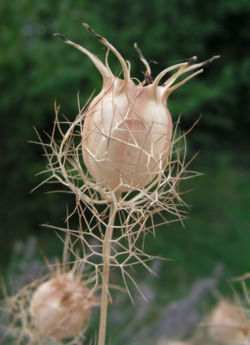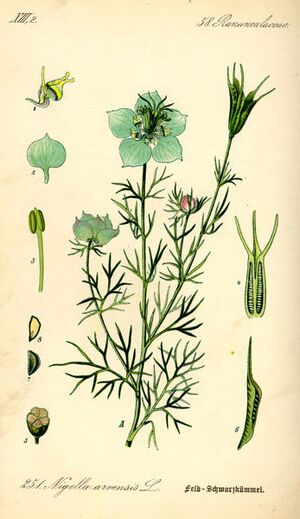Nigella: Difference between revisions
No edit summary |
No edit summary |
||
| Line 1: | Line 1: | ||
{{SPlantbox | |||
|genus=Nigella | |||
|Temp Metric=°F | |||
|jumpin=If this plant info box on watering; zones; height; etc. is mostly empty you can click on the edit tab and fill in the blanks! | |||
|image=Upload.png | |||
|image_width=240 | |||
}} | |||
{{Inc| | |||
Nigella (diminutive of niger, black; referring to the color of the seeds). Ranunculaceae. Love-in-a Mist. Devil-in-a-bush. Fennel-flower. Hardy annuals grown for their interesting flowers and seed- pods which are often surrounded by the much-divided involucre. | |||
Stems erect: Lvs. finely divided, alternate: fls. showy, white, blue or yellow; sepals 5, regular, petal-like, deciduous; petals 5, with hollow claws, notched or 2-lobed: carpels 3-10, fusing at the base into 1 cavity, cells opening at the top when mature; seeds many, black and hard. —About 12 species, including Garidella; mostly natives of the Medit. region. Following 3 are the only species now used in Amer. | |||
Nigellas require little care. The seed should be sown in the open border in good soil any time after the land is fit to work in early spring, as the plants are entirely hardy. The seedlings should be thinned, if necessary, to a distance of about 8 inches. They seldom succeed well if transplanted. If the seeds are sown in early autumn, the plants may withstand a mild winter and be ready to flower earlier the next summer. By planting at different seasons the plants may be continued in beauty nearly throughout the summer. The seeds of N. saliva, Linn., or black cummin, are sometimes used as seasoning in the Old World. | |||
}} | |||
{{no citations}} | {{no citations}} | ||
:''This article is about the plant. Nigella can also be a personal name; see e.g. [[Nigella Lawson]].'' | :''This article is about the plant. Nigella can also be a personal name; see e.g. [[Nigella Lawson]].'' | ||
Revision as of 08:27, 19 February 2010
| Nigella subsp. var. | ||||||||||||||||||||||||||||||||||||||||||||||||||||||||
|---|---|---|---|---|---|---|---|---|---|---|---|---|---|---|---|---|---|---|---|---|---|---|---|---|---|---|---|---|---|---|---|---|---|---|---|---|---|---|---|---|---|---|---|---|---|---|---|---|---|---|---|---|---|---|---|---|

|
|
| ||||||||||||||||||||||||||||||||||||||||||||||||||||||
| ||||||||||||||||||||||||||||||||||||||||||||||||||||||||
| Standard Cyclopedia of Horticulture |
|---|
|
Nigella (diminutive of niger, black; referring to the color of the seeds). Ranunculaceae. Love-in-a Mist. Devil-in-a-bush. Fennel-flower. Hardy annuals grown for their interesting flowers and seed- pods which are often surrounded by the much-divided involucre. Stems erect: Lvs. finely divided, alternate: fls. showy, white, blue or yellow; sepals 5, regular, petal-like, deciduous; petals 5, with hollow claws, notched or 2-lobed: carpels 3-10, fusing at the base into 1 cavity, cells opening at the top when mature; seeds many, black and hard. —About 12 species, including Garidella; mostly natives of the Medit. region. Following 3 are the only species now used in Amer. Nigellas require little care. The seed should be sown in the open border in good soil any time after the land is fit to work in early spring, as the plants are entirely hardy. The seedlings should be thinned, if necessary, to a distance of about 8 inches. They seldom succeed well if transplanted. If the seeds are sown in early autumn, the plants may withstand a mild winter and be ready to flower earlier the next summer. By planting at different seasons the plants may be continued in beauty nearly throughout the summer. The seeds of N. saliva, Linn., or black cummin, are sometimes used as seasoning in the Old World.
|
- This article is about the plant. Nigella can also be a personal name; see e.g. Nigella Lawson.
| Nigella {{{status}}} Fossil range: {{{fossil_range}}}
| ||||||||||||||||||||||||||||||||||||||||||||||||||||||||||||||||||
|---|---|---|---|---|---|---|---|---|---|---|---|---|---|---|---|---|---|---|---|---|---|---|---|---|---|---|---|---|---|---|---|---|---|---|---|---|---|---|---|---|---|---|---|---|---|---|---|---|---|---|---|---|---|---|---|---|---|---|---|---|---|---|---|---|---|---|
 Nigella damascena seed capsule | ||||||||||||||||||||||||||||||||||||||||||||||||||||||||||||||||||
| Plant Info | ||||||||||||||||||||||||||||||||||||||||||||||||||||||||||||||||||
| ||||||||||||||||||||||||||||||||||||||||||||||||||||||||||||||||||
| Scientific classification | ||||||||||||||||||||||||||||||||||||||||||||||||||||||||||||||||||
| ||||||||||||||||||||||||||||||||||||||||||||||||||||||||||||||||||
| [[{{{diversity_link}}}|Diversity]] | ||||||||||||||||||||||||||||||||||||||||||||||||||||||||||||||||||
| {{{diversity}}} | ||||||||||||||||||||||||||||||||||||||||||||||||||||||||||||||||||
| Binomial name | ||||||||||||||||||||||||||||||||||||||||||||||||||||||||||||||||||
| {{{binomial}}} | ||||||||||||||||||||||||||||||||||||||||||||||||||||||||||||||||||
| Trinomial name | ||||||||||||||||||||||||||||||||||||||||||||||||||||||||||||||||||
| {{{trinomial}}} | ||||||||||||||||||||||||||||||||||||||||||||||||||||||||||||||||||
| Type Species | ||||||||||||||||||||||||||||||||||||||||||||||||||||||||||||||||||
| {{{type_species}}} | ||||||||||||||||||||||||||||||||||||||||||||||||||||||||||||||||||
| Species | ||||||||||||||||||||||||||||||||||||||||||||||||||||||||||||||||||
| About 14, including: Nigella arvensis | ||||||||||||||||||||||||||||||||||||||||||||||||||||||||||||||||||
| [[Image:{{{range_map}}}|{{{range_map_width}}}|]] | ||||||||||||||||||||||||||||||||||||||||||||||||||||||||||||||||||
| Synonyms | ||||||||||||||||||||||||||||||||||||||||||||||||||||||||||||||||||
| {{{synonyms}}} |
Nigella is a genus of about 14 species of annual plants in the family Ranunculaceae, native to southern Europe, north Africa and southwest Asia. Common names applied to members of this genus are Devil-in-a-bush or Love in the mist.
The species grow to 20-90 cm tall, with finely divided leaves, the leaf segments narrowly linear to threadlike. The flowers are white, yellow, pink, pale blue or pale purple, with 5-10 petals. The fruit is a capsule composed of several united follicles, each containing numerous seeds; in some species (e.g. Nigella damascena), the capsule is large and inflated. Spread some in your yard, and it will reseed itself every year.
Uses
Culinary
The seeds of N. sativa, known as kalonji, black cumin (though this can also refer to Bunium persicum) or just nigella, are used as a spice in Indian and Middle Eastern cuisine. The dry roasted nigella seeds flavor curries, vegetables and pulses. The black seeds taste mostly like oregano crossed with pepper. Most people use it as a "pepper" in recipes with pod fruit, vegetables, salads and poultry.

Other uses
Several species are grown as ornamental plants in gardens, popular for their seed capsules, which are used in dried flower arrangements. Love in the mist are used exclusively for dried arrangements. These flowers are the best to add texture to any dried flower arrangement. The delicate, purple striped pods are used in several arrangements for an airy effect.
In India the seeds are used as a carminative and stimulant to ease bowel and indigestion problems and are given to treat intestinal worms and nerve defects to reduce flatulence, and induce sweating. Dried pods are sniffed to restore a lost sense of smell. It is also used to repel some insects, much like mothballs.
Drying Nigella
Nigella can be easily dried. Nigella is cut when pods reach maximum size and color. Nigella pods range from deep green to deep burgundy, with stripes in between. The first few pods are picked with as long a stem as possible, one at a time. The plant flowers profusely and so when most of the flowers become seed pods, pull the entire plant and cut the stems. Then wrap a rubber band around a small bundle of stems and then hang them upside down for drying in a dark, airy place until dry. Template:Ranunculales-stub